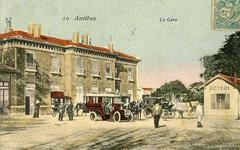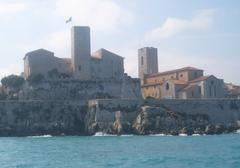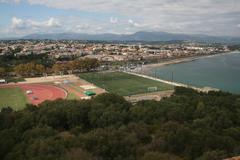
Antibes Cathedral: Visiting Hours, Tickets, and Historical Sites Guide
Date: 04/07/2025
Introduction: The Heart of Antibes’ Spiritual and Architectural Heritage
Set in the vibrant old town of Antibes along the French Riviera, Antibes Cathedral—officially Cathédrale Notre-Dame de l’Immaculée Conception d’Antibes—stands as a living witness to more than a millennium of religious tradition, architectural evolution, and community life. Erected atop the remnants of a Roman temple dedicated to Diana and Minerva, the cathedral’s foundations encapsulate Antibes’ journey from ancient paganism to a Christian stronghold (seeantibes.com, spottinghistory.com). Its distinctive ochre façade, intricate woodwork, and artistic treasures attract historians, architecture enthusiasts, art lovers, and spiritual seekers alike.
This guide delivers a comprehensive overview of Antibes Cathedral: from its layered history and architectural highlights to practical visitor information, accessibility tips, and nearby attractions. Whether you are planning your first visit or returning to rediscover its charms, this resource will help you experience the cathedral as a cornerstone of Antibes’ cultural identity.
Table of Contents
- Historical Background
- Architectural Features
- Religious and Cultural Significance
- Visiting Information
- Nearby Attractions and Travel Tips
- FAQ
- Conclusion and Practical Summary
- Sources
Historical Background
Pagan and Early Christian Roots
Antibes Cathedral’s story begins atop a Roman temple, an enduring symbol of the area’s spiritual significance even before Christianity. Archaeological traces of this temple survive in the Chapel of the Holy Spirit, underlining the site’s sacred status stretching back to antiquity (seeantibes.com).
Christianization took hold by the 5th or 6th century, when Saint Armentaire established the first Christian basilica here. Antibes soon became an episcopal seat, with local legend linking the site to Saint Paul’s brief imprisonment in 63 AD (spottinghistory.com).
Medieval Developments and Reconstructions
The cathedral endured Saracen raids, notably in 1124, prompting a major 13th-century reconstruction featuring the three-nave plan that defines the building today. The episcopal seat was later moved to Grasse, but Antibes Cathedral remained a key religious center. The 18th century saw further rebuilding after bombardment during the War of the Austrian Succession, with King Louis XV supporting the completion of its neoclassical façade in 1747 (ibnbattutatravel.com).
Key Historical Milestones
- 5th–6th centuries: First Christian basilica established by Saint Armentaire
- 1124: Destroyed by Saracen raiders; rebuilt in the 13th century
- 1608, 1746–1747: Major reconstructions; façade completed with Louis XV’s support
- 1801: Incorporated into the Diocese of Nice following the Concordat (seeantibes.com, spottinghistory.com)
Architectural Features
Exterior and Façade
The cathedral’s ochre and terracotta façade, rebuilt in 1747 after war damage, is an icon of Provençal style. Vivid orange and red hues, white cornices, and pilasters stand out against the Mediterranean sky, making the building instantly recognizable (provencelovers.fr, travelfranceblog.com). The façade’s sculpted tympanum, attributed to Joseph Dolle, features Saints Roch and Sebastian—local protectors.
Main Portal and Bell Tower
The walnut doors, carved in 1710 by Joseph (or Jacques) Dolle, depict intricate scenes and are masterpieces of local craftsmanship (wikipedia.org). The robust, square bell tower rises in Provençal Romanesque and early Gothic style, acting as a landmark for the old town (absoluty.com).
Interior Layout and Artistic Highlights
The cathedral’s basilica plan features a tall central nave, ribbed Gothic vaults, side aisles, and subtle stained glass windows that bathe the interior in colored light (francerent.com). The choir, part of the 12th-century rebuild, is the oldest surviving section.
Artistic Masterpieces
- Altarpiece by Louis Bréa (1515): A Renaissance treasure in the transept chapel (wikipedia.org)
- 19th-century marble statue of the Virgin Mary
- 16th-century holy water font
- Wooden Christ figures from 1447 and the 16th century
- 1860 Jungh pipe organ
Decorative carvings, heraldic symbols, and biblical scenes enrich the space (provencelovers.fr, fr.wikipedia.org).
Restoration Efforts
Continuous restoration, including a major 1991 campaign, has preserved the cathedral’s unique style and integrity. Archaeological studies have unearthed paleo-Christian remains, attesting to the site’s ancient roots (fr.wikipedia.org).
Religious and Cultural Significance
The cathedral is the main Catholic church in Antibes, central to the community’s spiritual life with Mass, sacraments, and major feasts such as the Assumption and Immaculate Conception. Its bells have long marked important civic and religious moments. Art and architecture reflect local heritage, with annual festivals and events supporting interfaith dialogue and cultural exchange (provencelovers.fr).
The cathedral’s proximity to the Mediterranean has made it a focal point for sailors and fishermen seeking blessings, reinforcing its role as a guardian of local identity.
Visiting Information
Opening Hours and Tickets
- General Opening: Tuesday to Sunday, 9:00 AM–6:00 PM (some sources note 8:00 AM–12:00 PM and 3:00 PM–7:00 PM; check locally for updates and event schedules)
- Closed: Mondays and some public holidays
- Admission: Free; donations appreciated for preservation (provencelovers.fr, seeantibes.com)
Guided tours and special events may require advance booking and a small fee.
Accessibility
- Entrances: Main entrance at street level, with ramps available for wheelchair users.
- Facilities: Accessible restrooms provided; some interior areas may be challenging due to the historic structure.
- Advice: Contact ahead for special needs or assistance (provencelovers.fr).
Guided Tours and Events
- Guided Tours: Offered seasonally via the Antibes tourism office; local guides often include the cathedral in city tours.
- Special Events: Concerts, heritage days, and major religious festivals are held throughout the year. Check local listings and the cathedral’s notice board for details.
Visitor Etiquette
- Dress Code: Modest attire (shoulders and knees covered) is expected.
- Photography: Permitted without flash; avoid disturbing worshippers, especially during services.
- Silence: Maintain quiet and respect the spiritual ambiance.
Nearby Attractions and Travel Tips
Top Nearby Sights
- Picasso Museum (Château Grimaldi): Steps away, featuring Picasso’s works (lonelyplanet.com)
- Provençal Markets and Old Town: Artisan shops, cafes, and lively squares
- Port Vauban Marina and Plage de la Gravette: Scenic waterside strolls
- Fort Carré: 16th-century fortress with panoramic views
Travel Tips
- Getting There: The cathedral is a 15-minute walk from Antibes train station; local buses serve the old town. Parking is available near the historic center.
- Best Time to Visit: Early mornings or late afternoons for fewer crowds and best light for photography.
- Combine with Local Markets: Enjoy culinary and artisan delights at the nearby Marché Provençal.
FAQ
Q: What are the opening hours of Antibes Cathedral?
A: Typically Tuesday–Sunday, 9:00 AM–6:00 PM. Confirm locally for updates.
Q: Is there an entrance fee?
A: No, admission is free; donations are welcome.
Q: Are guided tours available?
A: Yes, through the tourism office or as part of city walking tours.
Q: Is the cathedral accessible for visitors with reduced mobility?
A: The main entrance is accessible; some interior areas may be less so. Contact ahead for specific needs.
Q: Can I attend Mass as a visitor?
A: Yes, Mass is open to all. Typical times: Sundays at 10:00 AM, daily at 8:30 AM.
Q: Is photography allowed?
A: Yes, but please avoid flash and respect worshippers.
Conclusion and Practical Summary
Antibes Cathedral is a highlight of the Côte d’Azur—where history, art, and living faith converge in the heart of the old town. Its Roman roots, medieval reconstructions, and neoclassical grandeur make it a must-see for visitors seeking an authentic experience of Antibes’ layered past and vibrant present. Enjoy free entry, year-round access, and the chance to immerse yourself in both spiritual and cultural life. Combine your visit with nearby attractions—such as the Picasso Museum and local markets—for a rich, multifaceted exploration of the region.
For up-to-date visiting hours, tour options, and event schedules, consult the official Antibes tourism website and consider downloading the Audiala app for personalized audio guides and travel tips.
Sources
- seeantibes.com
- spottinghistory.com
- provencelovers.fr
- travelfranceblog.com
- wikipedia.org
- ibnbattutatravel.com
- fr.wikipedia.org
- francerent.com
- absoluty.com
- visitplacesfrance.com
- lonelyplanet.com








